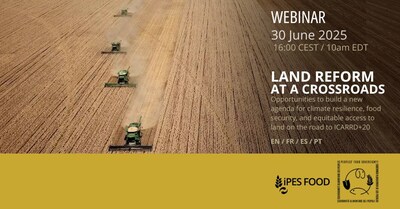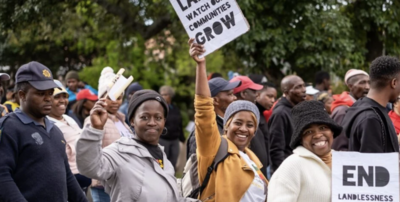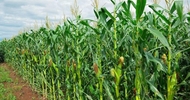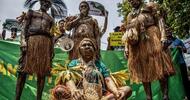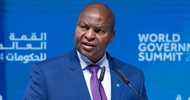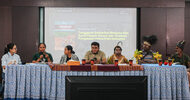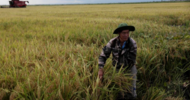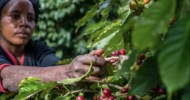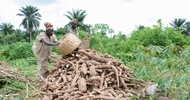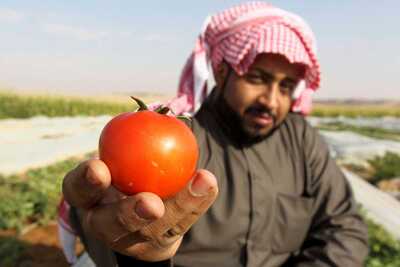 A farmer in Al Kharj, Saudi Arabia. The agriculture sector was worth $29bn in 2023. Photo: Reuters/Faisal Al Nasser
A farmer in Al Kharj, Saudi Arabia. The agriculture sector was worth $29bn in 2023. Photo: Reuters/Faisal Al NasserArabian Gulf Business Insights | 28 November 2024
Down on the farm, Saudi Arabia has a $9.8bn hole to fill
- Agriculture needs foreign investors
- 80% of Saudi food is imported
- Self-sufficiency is ultimate aim
The Saudi government is stepping up efforts to attract investors to its agriculture sector after identifying a funding gap of SAR37 billion ($9.8 billion).
The Ministry of Environment, Water and Agriculture says there are investment opportunities in plant and animal production, as well as fisheries, processing, manufacture of agricultural products and infrastructure development.
Saudi Arabia imports 80 percent of its food at the moment, but is working to increase domestic production as part of its Vision 2030 plans for food security.
Farming contributed about SAR109 billion to Saudi Arabia's economy in 2023 – up from just under SAR100 billion a year earlier. This was the sector's highest contribution so far, agriculture minister Abdulrahman Alfadley told a trade fair last month.
Foreign investors are a core component of the strategy to increase that figure, says Malachy Mitchell, co-founder of agribusiness consultancy Farrelly Mitchell.
“There's really enormous effort in terms of government policy, by way of incentives, soft loans through the Agricultural Development Fund and also to attract foreign direct investment."
The country's Public Investment Fund is heavily involved too, as a catalyst and as an investor through its subsidiary Saudi Agricultural and Livestock Investment (Salic).
Saudi Arabia has become a more attractive place to invest now that 100 percent foreign ownership is permitted in a lot of sectors, according to Mitchell.
Private equity funds are looking at opportunities, “particularly businesses that are cash flow positive and established and have good strong growth characteristics”.
Saudi companies want to partner with international businesses that have the expertise and the market reach to help them develop "the local food chain”.
Mitchell says: “There is a genuine drive and determination towards improving localisation and to get to self-sufficiency. It's not just an objective.”
Ibrahim Malas, senior business development manager at Elite Agro Holding in Abu Dhabi, points out that some farm businesses are still recovering from the hit they took in 2018, when they were banned from growing alfalfa – used to feed cattle – because the process consumes so much water.
Nadec, Almarai and Al Safi all closed massive farms, which led to smaller farms trying to fill the void by supplying the big dairies.
Like other countries in the region, Saudi Arabia looked to buy land overseas and grow alfalfa for import. This has not proved trouble-free, though. An Almarai subsidiary in Arizona faces a lawsuit over the amount of water it is using.
Improving water management is one of the areas being studied at Estidama, the national agricultural research centre set up in 2019.
The centre's research is also helping farmers to increase crop yields, says Yoshihide Wada, a professor at King Abdullah University of Science and Technology and an expert in global hydrology and food security.
Changes in Saudi eating habits are having an impact on food producers too. Restaurants “are increasingly focusing on healthy foods and higher-quality agricultural commodities", Wada says.
Perhaps even more surprising, “10 percent of the Saudi population is now considered as vegetarian/vegan" – a big shift from the traditional "meat-oriented culture".
On the road to self-sufficiency
- Saudi potato production has increased sharply in recent years. It now has a "self-sufficiency rate" of 86 percent, says the agriculture ministry.
- Aquaculture production jumped by 183 percent over the past five years, from 30,000 tonnes to 85,000 tonnes, according to government figures. Malas says farming giant Almarai is being encouraged to move into aquaculture because the agriculture minister "knows that Almarai will systemise it, and they can make it sustainable like they've done with the poultry industry”.
- Broiler chicken production now meets 60 percent of domestic demand.
- Controlled-environment agriculture – which Malas describes as "flavour of the month" for investors, though costly – has increased by 58 percent over the past five years, from 257,000 tonnes to around 407,000 tonnes.
- Organic food farming increased by 18 percent to 52,800 tonnes in the same period.
- The poultry market – supported by the arrival of Brazilian producers BRF and JBS – is about 70 percent self-sufficient. It is projected to reach $17.3 billion in 2024.


